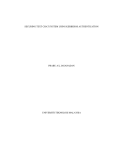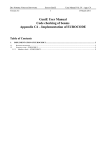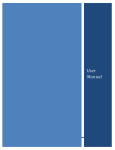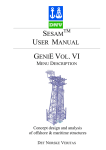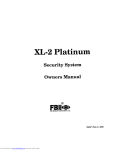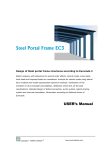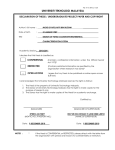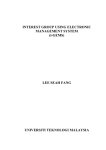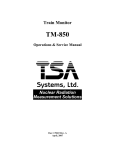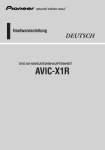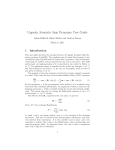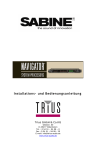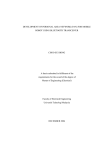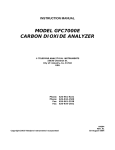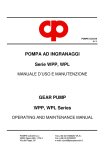Download borang pengesahan status tesis - Universiti Teknologi Malaysia
Transcript
PSZ 19: 16 (Pind. 1/97) UNIVERSITI TEKNOLOGI MALAYSIA BORANG PENGESAHAN STATUS TESIS JUDUL: DESIGN OF STEEL TRUSS ELEMENT WITH EUROCODE 3 USING VISUAL BASIC SESI PENGAJIAN: 2008/2009 Saya GERARD J.JOEPLIK (HURUF BESAR) mengaku membenarkan tesis (PSM/Sarjana/Doktor Falsafah)* ini disimpan di Perpustakaan Universiti Teknologi Malaysia dengan syarat-syarat kegunaan seperti berikut: 1. 2. 3. 4. Tesis adalah hakmilik Universiti Teknologi Malaysia. Perpustakaan Universiti Teknologi Malaysia dibenarkan membuat salinan untuk tujuan pengajian sahaja. Perpustakaan dibenarkan membuat salinan tesis ini sebagai bahan pertukaran antara institusi pengajian tinggi. ** Sila tanda (√) √ SULIT (Mengandungi maklumat yang berdarjah keselamatan atau kepentingan Malaysia seperti yang termaktub di dalam AKTA RAHSIA RASMI 1972) TERHAD (Mengandungi maklumat terhad yang telah ditentukan oleh organisasi/badan di mana penyelidikan dijalankan. TIDAK TERHAD Disahkan oleh (TANDATANGAN PENULIS) (TANDATANGAN PENYELIA) Alamat tetap: P.O.BOX 319, MENGGATAL 88450, KOTA KINABALU, SABAH Tarikh: 4 APRIL 2009 PROF. DR. SHAHRIN MOHAMMAD Nama Penyelia Tarikh: 4 APRIL 2009 CATATAN: * Potong yang tidak berkenaan. ** Jika tesis ini SULIT atau TERHAD, sila lampirkan surat daripada pihak berkuasa / organisasi berkenaan dengan menyatakan sekali sebab dan tempoh tesis ini perlu dikelaskan sebagai SULIT atau TERHAD. ♦ Tesis dimaksudkan sebagai tesis bagi Ijazah Doktor Falsafah dan Sarjana secara penyelidikan, atau disertasi bagi pengajian secara kerja kursus dan penyelidikan, atau Laporan Projek Sarjana Muda (PSM). “I hereby declare that I have read this thesis and in my opinion this thesis is sufficient in terms of scope and quality for the award of the degree of civil engineering” Signature : …………………………………………………………….. Name of Supervisor : PROF. DR. SHAHRIN MOHAMMAD Date 4 MAY 2009 : DESIGN OF STEEL TRUSS ELEMENT WITH EUROCODE 3 USING VISUAL BASIC GERARD J.JOEPLIK A report submitted in partial fulfillment of the requirements for the award of the degree of Bachelor of Civil Engineering Faculty of Civil Engineering Universiti Teknologi Malaysia 4 MAY 2009 ii I declare that this thesis entitled “Design of Steel Truss Element With Eurocode 3 Using Visual Basic” is the result of my own research except as cited in the references. The thesis has not been accepted for any degree and is not concurrently submitted in candidature of any other degree. Signature :……………………………………………. Name : GERARD J.JOEPLIK Date : 4 MAY 2009 iii Special dedication to my parents and my siblings, my friends, and also my great supervisor Prof. Dr. Shahrin Mohammad iv ACKNOWLEDGEMENTS First and foremost, thanks to the Lord because by His fruitful blessing that I would have the strength to do this project. Secondly, I would like to thank my project supervisor, Prof. Dr. Shahrin Mohammad who had guided me from the beginning of this project until the end of this project despite of his bustling and hustling life as a Dean of the Faculty of Civil Engineering, Universiti Teknologi Malaysia. Without his tender help, I am surely will encounter deep problem in accomplishing this project. Not to forget, I would like to thanks my friend, Dee Aguindrew Gundeh, who had helped and always be there for me in solving the problems I faced during the development of this project. Also to all my friends whom had gave me the best moment and encouragement for the whole year in bringing to the end of the project. Finally, I would like to express my heartfelt gratitude to my family, for their endless support. May the mighty Lord grant all of you with His blessing. Thank you so much. v ABSTRAK Rekabentuk dalam pembinaan menggunakan keluli telah meningkat terutama sekali negara yang berkembang maju. Kajian ini adalah berkaitan dengan penghasilan sebuah perisian yang bertujuan membantu pengguna dalam pengiraaan rekabentuk anggota kekuda keluli dengan mengunakan keluaran terbaru Eurocode 3 EN 1993. Program yang dihasilkan ialah “Steel Truss Design” dan dihasilkan menggunakan Visual Basic 6.0. Eurocode 3 telah diimplementasikan ke dalam pengiraan rekabentuk dan semua hasil pengiraan akan dibandingkan dengan hasil pengiraan secara manual untuk proses pengesahan. Dengan kepuasan dalam proses pengesahan tersebut, sebuah jadual kapasiti akan dihasilkan dengan menggunakan perisian tersebut dan kajian parametrik akan dijalankan. Daripada kajian parametrik tersebut, pengguna boleh lebih memahami tentang sifat-sifat seksyen keluli. Di akhir kajian ini, boleh disimpulkan, perisian ini boleh digunakan untuk membantu pengguna untuk merekabentuk anggota kekuda dengan tepat dan lebih mudah. vi ABSTRACT The designs of construction using steel have been upgraded especially in the well developed country. This is a study of developing a computer program in order to aid user to calculate the design of steel truss member using the latest version of Eurocode 3 EN 1993. The program is called Steel Truss Design and developed using Visual Basics 6.0. Eurocode 3 is implemented in the calculation of the design and all results from the computer program will be compared with the manual calculation. Upon a satisfactory of the validation process, a capacity table is produced by using the software, and parametric study is carried out. From the parametric study, designer will be able to understand more of the properties behavior of section. At the end of the study, it can be conclude that Steel Truss Design program can be use to help user to design truss member accurately and easily. vii CONTENTS CHAPTER 1 TITLE PAGE TITLE i DECLARATION ii DEDICATION iii ACKNOWLEDGEMENT iv ABSTRAK v ABSTRACT vi CONTENTS vii LIST OF TABLES x LIST OF FIGURES xi LIST OF SYMBOLS xii LIST OF APPENDICES xiv INTRODUCTION 1 1.1 General 1 1.2 Problem Statement 3 1.3 Objective 4 1.4 Scope of Thesis 4 1.5 Contents of Thesis 5 viii 2 LITERATURE REVIEW 6 2.1 Visual Basic 7 2.1.1 Introduction to Visual Basic 7 2.1.2 The core of Visual Basic 8 2.1.2.1 Event Driven Programming 9 2.1.2.1 Object Oriented Programming 9 Visual Basic Environment 10 2.1.3.1 Visual Basic Window 10 2.1.3.2 Main window 10 2.1.3.3 Form1 and form designer window 10 2.1.3.4 Toolbox 10 2.1.3.5 Project Explorer window 11 2.1.3.6 Properties window 11 2.1.3.7 Form layout window 11 2.1.3.8 Code window 12 2.1.3 2.2 Introduction to Eurocode 3 12 2.3 Steel design 14 2.3.1 Basic of design 14 2.3.2 Steel Truss Design 15 2.3.3 Design of Steel Truss Using Eurocode 3 16 2.3.3.1 Design of compression member with axially loaded 16 2.3.3.2 Design of tension member with axially loaded 2.4 3 Conclusion 28 32 METHODOLOGY 33 3.1 Introduction 33 3.2 Preliminary study 34 3.3 Flow chart establishment 35 3.4 Program Review 36 ix 4 5 6 3.5 Developing program 36 3.6 Checking of program 36 3.7 Program debugging 37 3.8 Program validation 38 3.9 Result validation 38 3.10 Parametric Study 40 3.11 Conclusion 41 USER MANUAL 42 4.1 Introduction 42 4.2 Steel Truss Design 43 4.2 Steel Truss Design main form 44 4.2 Result form 48 4.2 Parametric study form 50 4.2 Conclusion 51 RESULTS ANALYSIS AND DISCUSSION 52 5.1 Introduction 52 5.2 Parametric Study 53 5.3 Discussion 60 5.4 Conclusion 61 CONCLUSION AND RECOMMENDATION 62 6.1 Conclusion 62 6.2 Recommendations 63 REFERENCES APPENDIX 65 66-83 x LIST OF TABLES TABLE NO. 2.1 TITLE PAGE Nominal values of yield strength fy and ultimate tensile strength fu for hot rolled structural steel 2.2 (continued) Nominal values of yield strength fy and ultimate tensile strength fu for hot rolled structural steel 2.3 19 Maximum width-to-thickness ratios for compression parts (Sheet 1 of 3) 2.5 18 Maximum width-to-thickness ratios for compression parts (Sheet 1 of 3) 2.4 17 20 Maximum width-to-thickness ratios for compression parts (Sheet 3 of 3) 21 2.6 Selection of buckling curve for a cross-section 25 2.7 Reduction factors β2 and β3 29 3.1 Steel Truss design 1: Circular hollow section truss member (Compression) 3.2 Steel Truss design 2: Square hollow section truss member (Compression) 3.3 40 Steel Truss design 5: Equal section truss member (Bolted tension member) 3.6 39 Steel Truss design 4:Equal section truss member (Bolted tension member) 3.5 39 Steel Truss design 3: Square hollow section truss member (Compression) 3.4 39 40 Steel Truss design 6: Equal section truss member (Welded tension member 40 xi LIST OF FIGURES FIGURE NO. TITLE PAGE 2.1 Main window for Visual Basic 2.2 Truss elements 15 2.3 Buckling curves 26 2.4 Angles connected by one leg 30 4.1 Interface of the opening window ‘opening form’ 43 4.2 Truss info tab 45 4.3 Section properties tab 46 4.4 Bolted connection for angles form 47 4.5 Check design tab 48 4.6 Calculation and result interfaced 49 4.7 Capacity Table 50 5.1 Capacity table for compression Structural Tee Cut from Universal Beam. 5.2 54 Capacity table for compression Square Hollow Sections. 5.4 53 Capacity table for compression Structural Tee Cut from Universal Column. 5.3 9 55 Capacity table for compression Rectangular Hollow Sections. 56 5.5 Capacity table for Compression Equal Angles. 57 5.6 Capacity table for Compression Unequal Angles. 58 5.7 Capacity table for Compression Circular Hollow Sections. 59 xii LIST OF SYMBOLS A - Area Anet - Nett area b - Width of section β2 - Reduction factor for two bolts β3 - Reduction factor for three bolts or many. d - Depth between fillets d0 - Hole diameter for a bolt, a rivet or a pin. e2 - The edge distance from the centre of a fastener hole to the adjacent edge of any part, measured at right angles to the direction of load transfer, E - Modulus of elasticity fy - Yield strength fu - Ultimate tensile strength h - Depth of section hw - Height of web Iy - Second moment of area (Y-Axis) Iz - Second moment of area (Z-Axis) NEd - Design value of the compression force Nc, Rd - Design resistance to normal forces of the cross-section for uniform compression Nt, Rd - Design values of the resistance to tension forces. Npl, Rd - Design plastic resistance to normal forces of the gross cross section Nu, Rd - Design ultimate resistance to normal forces of the net cross section at holes for fastener Ncr - Elastic critical buckling force Nb, Rd - Cross-section buckling resistance xiii p1 - Spacing between canters of fasteners in a line in the direction of load transfer, r - Root radius tf - Flange thickness tw - Web thickness Wpl, y - Plastic modulus (Y-Axis) Wel, y - Elastic modulus (Y-Axis) γM - General partial factor. xiv LIST OF APPENDICES APPENDIX NO. TITLE PAGE A-1 Flow chart for compression member 68 A-2 Flow chart for tension member 73 B-1 Truss Design of Member Subjected to Compression Load 1 B-2 Truss Design of Member Subjected to Compression Load 2 B-3 81 Truss Design of Bolted Member Subjected to Tension Load 2 B-6 79 Truss Design of Bolted Member Subjected to Tension Load 1 B-5 77 Truss Design of Member Subjected to Compression Load 3 B-4 75 83 Truss Design of Welded Member Subjected to Tension Load 85 CHAPTER I INTRODUCTION 1.1 General Human civilization in the construction area has been develops majorly. As the countries experienced a steady progression, one of the major industries benefitting from this development is the construction industry. Besides concrete, steel structure could provide better choice for construction present needs especially when there is shortage of cement, influx of the unskilled labor and the stressed of achieving high quality structure by the government. (Ahman Fikri Hussein and Mohd Zulkifli Ghazalie, 1996) By considering the vast development of steel construction, more material of steel is need. Some high quality used steel is recycled and some produced. Steel is produced b refining iron ore and scrap metal together with appropriate fluxing agents, coke (for carbon), and oxygen in high-temperature furnaces to produce large masses of pi iron. Steel is the most widely used metal as a construction material due to the combination of several factors such a high strength, durable, good ductility, high stiffness and relatively cheap if taken into account speedy in construction time. (Steel Technology Center, Universiti Teknologi Malaysia) 2 Malaysia, as one of the fastest developing country in the Southern Asian region did not really used steel in construction until mid 80’s. by then, Steel started to be used mainly for industrial buildings such as factories and warehouse. Presently, there are few companies that are involved in steel production for example Parana Steel Sdn.Bhd, BHP Lysaght Malaysia, Antara Steel Sdn.Bhd, and Amalgamated Industries Steel Sdn.Bhd. There are several steel buildings in Malaysia, such as Menara Promet, Menara PNB, Dayabumi, and some used steel as the main frame system which is Weld tower and also The Petronas Twin Tower Which utilizes steel beams and metal decking floor system. (Ahman Fikri Hussein and Mohd Zulkifli Ghazalie, 1996) Apparently the prospect of steel construction in Malaysia seems to bright in the future. More design of steel structural will be studied. In structural design, its involved deep understanding, long calculation and consideration while designing structure. This will affect the cost, time and human resource involved in the design and analysis. The development of computer software program for structural design had help many designer in reducing time and cost, ensure consistency and accuracy in calculation and provide easy understanding for new designer. (Hii How Nguong, 2006) As what we can see in the design practice especially Malaysia, almost all designers are still using the British Standard (BS). While BS 5950 is still being used in steel structural design and analysis, the emergence of Eurocode 3 had it own role for providing more practical and economical design. EN Eurocode will replace British Standard in the future. So, it is very important Eurocode 3 to be put into practice in the industry throughout Malaysia. 3 1.2 Problem Statement Since publication in November 2005, Eurocode had been given a National Standard status, any conflicting National Standards will be withdrawn by March 2010. The new code will be replacing the old code which mostly refers to British Standard (BS) code of practice (European Committee For Standardization, 2005). In Malaysia, almost all company and education institution is still using BS. Although many structural engineering still practicing British Standard code, it is very important to learn and implement new code in order to stay advanced. Not only the standard matter in this project, but most of the design and analysis of building involved a very long calculation, and it took time to be completed. One best solution for this matter is to build a computer software which able to calculate faster, accurate, and consistence. It will not only provide easier way to design and analysis but also will give instant experience of engineering experience. For this project, there is software which is developed by previous students. The program is called Steel Structure Design (SSD) which it is developed using Visual Basic 6. But, the software is out-dated since code used for the design of structure is ConciseEurocode 3 (C-EC 3). So, there is still need to create a new software which is using the latest EN 1993 Eurocode 3. 4 1.3 Objective With the purpose to cope with the problem, there are four main objectives had been set in this study: i. To create software that able to calculate for compression and tension members of the truss design using Eurocode 3 EN 1993-1-1. ii. To provide a parametric study in the software in order to compare the behavior of the cross sections. iii. To produce a member capacity table for truss member subjected to axially compression load. 1.4 Scope of Thesis In order to ensure the objectives are achieved, several scopes needed to be stated so that the research does not turn aside from the real purpose of the study. In this project, the study will only be focused on truss design. The software will be developed for the design of truss member. Furthermore, the concern of the design of truss member will only consist of compression and tension member. There will be no shear resistance or bending resistance matters. The design will be about calculation for the cross section resistance and buckling resistance of the truss member. 5 The study of truss and the design will be fully based on EN 1993 Eurocode 3 2005, the latest version of steel design in Eurocode. All of the cross section of members will be base on the Eurocode 3 table of properties. The software will be developed by using Visual Basic 6 as the programming code. Microsoft Access will be use for the database of the tables of properties. The software will only mean to design for hot rolled sections. Moreover, all connections between truss members are assumed to be pin connected. At this moment, this computer program can only carry out the design of each truss member. The design approach of the software also will not include the design of slender steel segment and high shear steel segment. 1.5 Contents of Thesis In this report, there will be five chapters prepared. Chapter 1 is the introduction chapter which contain brief introductory about the research, the problem of the research, the aims of the study and also the scope of research. In Chapter 2 concern will be stressed on the literature review. It contains some article of the Visual Basic program, the design and analysis of steel truss and also EN 1993 Eurocode 3. In Chapter 3, the procedure for conducting this study and all methods used are highlighted. For Chapter 4 emphasize on the analysis and measurement work done on the accuracy of the program. For chapter 5, is the conclusion for the whole project and recommendation for future research. CHAPTER II LITERATURE REVIEW For every research study, there is a lot of review need to be done. The literature review of the study is divided into 3 main sections. The first section is about the programming language, Visual Basics 6.0. It contains brief introduction, concept and the environment of visual basics 6.0. Then the second section is concern on the Eurocode 3. The third section is about the steel truss design which consists of the step of design following the code of Eurocode 3. 2.1 Visual Basic 2.1.1 Introduction to Visual Basic The program used to create the software is Visual Basic. Visual Basic is a programming language which provide good introduction to window programming. The integrated development environment (IDE) allow user to create fully fledged windows 7 applications with the minimum of effort and time. The window of the application can be drawn on the screen; therefore user can always see what the output application will look like without having to guess according to the code written for the program. Visual Basics avoid the long-winded trial and Error approach to designing screen displays of the older programming languages. (Stephen Morris, 1997) Visual Basic had been developing together with other programming language. Microsoft first released Visual Basic in 1987. It was the first visual development tool form Microsoft, and it was to compete with C, C++, Pascal and other well-known programming languages. From the start, Visual Basic was not well-known until the release of Version 2.0 that people realized the capability of the language, and with release of version 3.0 it had become a phenomenon and fastest-growing programming language on the market. Visual Basic continue to grow as a major programming tool and the latest released is Visual Basic.net which superseded Visual Basic 6. (startvbdotnet, 2004-2007). 2.1.2 The core of Visual Basic For being a well established programming language, some of the important features of Visual Basic are the Object Oriented Programming (OOP) and Event Driven Programming which will briefly covered later. Other than that is the ability to allow programmer to develop a program which consist of Graphical User Interface (GUI). Now instead of the cryptic C:> prompt that DOS users have long used, desktop now enhanced with icons and with programs that use mice and menus (Gary Cornell, 1997) 8 2.1.2.1 Event Driven Programming One of the Visual Basic feature is Event Driven Programming. Programs written in Visual Basic are called Event Driven Programming, An event is something that happens that the computer can detect typical events include: a) Clicking a mouse button b) Typing a character on a keyboard c) Deleting or changing a value When an even occurs, the program will execute the programming statements related with that programmed event, called as event procedure. When that event procedure completes execution, control returns to be application even-driven programs give the user a lot of control over the action of application. 2.1.2.2 Object Oriented Programming Another special feature of Visual Basic is Object Oriented Programming (OOP) language. A major factor in the invention of object oriented is to remove some of the flows encountered with procedural approach. In OOP, data is treated as critical element and does not allow it to flow freely. It bounds data closely to the functions that operate on it and protects it from accidental modification from outside function. OOP allows decomposition of a problem into an object and then build functions around the object. The major advantage of OOP is code reusability. (startvbdotnet.com, 20042007) 9 2.1.3 Visual Basic Environment When Running a Visual Basic Program, the new Project Window will appear. This dialogue box effectively provides a menu for deciding what work is going to be done. To start creating program, the standard.exe should be clicked twice. 2.1.3.1 Visual Basic Window Figure 2.1: Main Windon for Visual Basic 6 2.1.2.3 Main Windows 10 The main window contains the entire element that can be found in a windows application. The title bar contains the name of the current project (initially project 1) and the usual buttons for minimizing, maximizing and closing window, and the menu bar includes eight pop down men. The toolbar contains a number of icons that provide shortcut to the most frequently used Visual Basic operations. On the night two sets of figures provide information about any selected Visual Basic element. 2.1.2.4 Toolbox Most Programs contains a number of different objects such as command button, text boxes, and labels and so on. These are call control and it can be added to application by dragging them from the toolbox. 2.1.2.5 Form1 and form Designer window. To start off, Visual Basic supplies a single form called Form 1. This form will be renamed and resized when developing an application. Other forms will be added as required. 11 Project Explorer window For each window in final application, there is a corresponding Visual Basic form, and each form has its own file on disk. At least one file containing the program code for the application and if the forms use an third party tools, those will be held in additional files. All files go together to make up the project form which the application is built. 2.1.2.6 Properties window Each form and each control on a form has a set of properties. These determine the appearance of the form or control and the way in which it behaves. The properties window displays the properties for the selected form on control, and allows you to change them. 2.1.2.7 Form layout window The form layout windows helps user to determine the initial position of the forms on the screen when application is run. 12 2.1.2.8 Code window Code window only being call out when programmer are ready to type Visual Basic program statement for project. Like the form window, it is sizable and movable. Each form has its own code window. (Stephen Morris, 1997) 2.2 Introduction to Eurocode 3 EN 1993 Eurocode 3 is use to design of building and other civil engineering works in steel. It follows the principles and requirements for the safety and serviceability of structures, the basis of their design and verification that are given in EN 1990 – Basis of structural design. EN 1993 Eurocode 3 is concerned with the requirement for resistance, serviceability, durability and fire resistance of steel structure. (CEN, 2005) Work began on the set of structural Eurocodes in 1975. For structural steelwork, the responsible committee, under the chairmanship of Professor Patrick Dowling of Imperial College London, had the benefit of the earlier European Recommendations for the Design of Structural Steelwork, prepared by the European Convention for Constructional Steelwork in 1978. Apart from the obvious benefit of bringing together European experts, preparation of this document meant that some commonly accepted design procedures already existed. E.g. the European column curves. Progress was, however, rather slow, and it was not until the mid 1980s that the official draft documents, termed ENVs, started to appear. The original, and Unchanged, main grouping of Eurocodes, comprises 10 documents: EN 1990, covering the basis of structural design, EN 1991, covering actions on structures, and eight further documents essentially covering each of the structural materials (concrete, steel, masonry etc). (L Gardner and D A Nethercot, 2005) 13 Eurocode 3 EN 1993 is wider in scope compared to other EN Eurocode due to the diversity of steel structures, the need to cover both bolted and welded joints and the possible slenderness of construction. EN 1993 has about 20 part covering common rules, fire design, bridges, building, tanks, silos, pipelined piling, crane supported structures, towers and masts, chimneys etc. (Eurocodes.Jrc.ec.europa.eu, 2005) EN Eurocode 3 is intended to be used in conjunction with, 1. EN 1990: Eurocode – Basis of Structural Design; 2. EN 1991: Eurocode 1 – Actions on structures; 3. ENs, ETAGs and ETAs for construction product relevant for steel structures; 4. EN 1090: Execution of Steel Structures - Technical requirements. 5. EN 1992 to EN 1999 when steel structures or steel components are referred to (Eurocodes.Jrc.ec.europa.eu, 2005) In Eurocode 3 EN 1993, the design of steel structures shall be in accordance with the general rules given in EN 1990 with some supplementary provisions in the code. The basic requirements of EN 1990 section2 should be satisfied where limit state design is used in conjunction with the partial factor method and the load combinations given in EN 1990 together with the actions given in EN 1991. The rules for resistances, serviceability and durability given in the various parts of EN 1993 should be given.(CEN, 2005) 14 2.3 Steel Design 2.3.1 Basic Of Design The design of a structural member required the selection of the cross section that will safely and economically resist the applied load. Economically usually means minimum weight of steel which correspond to the cross section with smallest weight per meter, which is one of the smallest cross sectional area. (William T.Segui) At the start of structural design, an engineer must make a number of basic choices, among them being the materials to be used in construction and the structural system in which they are to be used; the number of material commonly used in primary structural systems is limited. A list that includes steel, reinforced and unreinforced masonry (concrete and other) wood and aluminum would be almost exhaustive for most definition of primary structures. (SOL.E.Cooper, 1985) Limit states design provides the basic framework within which the performance of the structure can be assessed against various limiting conditions. When formulating procedure nowadays, it is customary to do so in a way which recognized the inherent variability of loads, materials, construction practices and approximations made in design; this usually involves the use of some concept of probability. The limiting conditions are normally grouped under two headings. Ultimate or safety limit states and serviceability limit states. (David A.Nethecot, 2001) Other consideration, such as ease of construction, may ultimately affect the choice of member size, the process begins with the selection of the lightest cross section shape that will do the job. After that engineer must decide on hot to construct if safely. (William T.Segui, 2003) 15 2.3.2 Steel Truss Design Trusses and lattice girders are structures composed of triangulated members joined together at their end points. Welding or bolting of the member of by using gusset plate forms the joint connections. Pitched trusses are usually used for roofs while parallel chord lattice girders are employed to support roofs, floor and for bridges. Trusses can be delivered to construction site as one complete unit, as several units or even as individual elements they may provide added advantages.(Steel Technology Center, Universiti Teknologi Malaysia) Figure 2.2: Truss Elements Generally, truss element can be divided into three categories, Top cord, Bottom cord and inner member or web cord (refer to figure 2.3.2). When a truss is subjected to a given loading, the force developed in each member is either tensile or compressive and in certain cases even bending. In order to design the members and the connection of the truss, it is necessary to calculate these forces. (Hii How Nguong, 2006) The use of rolled hollow sections for trusses provides a far more efficient use of material as the buckling strengths are higher as radii of gyration are larger and lateral torsional buckling is either non-existent in the case of square or circular sections, or the effects are much reduced for rectangular sections. (Lawrence Martin and John Purkiss, 2008) 16 2.3.3 Design of Steel Truss using Eurocode 3 2.3.3.1 Design Compression members with axially loaded For compression member, design is made with the concern of both cross section resistance and buckling resistance. The procedure of designing a compression member is as below: i. For the Ultimate Limit State, the design axial compressive force NED for the relevant load case is determined using partial safety factors. Fy = 1.35Gk + 1,5Qk ii. Select steel grade and material property. (EN 1993-1-1 Table 3.1) 17 Table 2.1: Nominal values of yield strength fy and ultimate tensile strength fu for hot rolled structural steel Table 2.2: (continued): Nominal values of yield strength fy and ultimate tensile strength fu for structural hollow sections 18 iii. Classify Cross Section in compression. (EN 1993-1-1 Table 5.2) 19 Table 2.3: Maximum width-to-thickness ratios for compression parts (Sheet 1 of 3) 20 Table 2.4: Maximum width-to-thickness ratios for compression parts (Sheet 2 of 3) 21 Table 2.5: Maximum width-to-thickness ratios for compression parts (Sheet 3 of 3) 22 iv. Resistance of cross section checking For tension force at each cross section should satisfy: : Clause 6.2.3(1) For section with holes the design tension resistance Nt,Rd should be taken as the smaller of : a) The design plastic resistance of the gross-section : Clause 6.2.3 (2) b) The design ultimate resistance of the net cross-section at holes for fasteners. : Clause 6.2.3(4) The clause 6.1 Note 2B partial factors γMi for building may be defined in the National Annex, the following numerical values are recommended for buildings: For design value of compression force at Ned at each cross-section should satisfy: : Clause 6.2.4 (1) The design resistance of the cross section for uniform compression Nc,Rd should be determined as follows: 23 : Clause 6.2.4 (4) The clause 6.1 Note 2B partial factors γMi for building may be defined in the National Annex, the following numerical values are recommended for buildings: v. Determine the buckling length L for each axis By referring to BB.1 Flexural buckling of members in triangulated and lattice structures. BB.1.1 General (1)B For chord members generally and for out of plane buckling of web member, the buckling length Lcr may be taken as equal to the system length L, see BB.1.3(1)B, unless a smaller value can be justified by analysis. (2)B The buckling length Lcr of an I ar H section chord member may be taken as 0,9L for in-plane buckling and 1,0L for out-of plane buckling, unless a smaller value is justified by analysis. (3)B Web members may be designed for in-plane buckling using buckling length smaller than the system length, provided the chords supply appropriate end restraint and the end connection supply appropriate fixity (at least 2 bolts if bolted) (4)B Under these condition, in normal triangulated structures the buckling length Lcr of web members for in-plane buckling may be taken as 0,9L, except for angle section, see BB.1.2 and BB.1.3 vi. Determine the slenderness for each axis 24 For Flexural buckling refer to 6.3.1.3, the non-dimensional slenderness λ is given by: :Clause 6.3.1.3(1) Where: Lcr is buckling length in the buckling plane considered ii is the radius of gyration about the relevant axis, determined using the properties of the gross cross section Note B for elastic buckling of components of building see Annex BB. vii. Select the appropriate buckling curve for each axis, for the type of cross section and thickness of steel For Flexural buckling the appropriate buckling curve should be determined from Table 6.2 and Table 6.4 to find for χ or refer to clause 6.3.1.2. 25 Table 2.6 : Selection of buckling curve for a cross-section 26 Figure 2.3: Buckling curves Besides using the buckling curve, for easy programming of the software, another alternatives approached was taken to calculate the value of reduction factor, χ. The method is by using the equation 6.49 in clause 6.3.1.2. 27 α is an imperfection factor Ncr is the elastic critical force for the relevant buckling mode based on the gross cross sectional properties. The Ncr value for flexural buckling can be calculated by using this equations. (L Gardner and D A Nethercot, 2005) viii. Determine the buckling resistance From the value of χ obtained, used equation from clause 6.3.1(3) to determine the buckling resistance. : clause 6.3.1(3) Where χ is the reduction factor for the relevant buckling mode. ix. Compare the buckling resistance with the design axial force. If Nb,Rd > NEd then the selected section is satisfied. Refer to clause 6.3.1.1 2.3.3.2 Design Tension members with axially loaded The biggest consideration that must be given for tension member in structural steel is the end connections due to bolt holes and the possible occurrence of stress reversal causing the member to buckle as a compression 28 member. It is crucial to check on the possible reduction of the resistance at the end connection. The step of analysis is as following: i. Step i to iii will be the same step of tension member design. ii. Classify the section in tension fu from table 3.1 in clause 3.2.3 iii. Identify the diameter of bolt (D), bolt holes (do) and amount of bolt. iv. Identifying net area, Anet Anet = Ag - Σdot Anet is the net area of the angle. For an unequal-leg angle connected by its smaller leg. Anet should be taken as equal to the net section area of an equivalent equal-length angle of leg size equal to that of the smaller leg. v. Determine the design plastic resistance of the gross section, NplRd : clause 6.2.3 (2) (a) vi. Determine the design ultimate resistance of the net section. For member without bolt connection at end : clause 6.2.3(2)(b) 29 For angles connected by one leg refer to clause 3.10.3 from EN 1993-1-8 2005 Where: β2 and β3 are reduction factors dependent on the pitch p1 as given in Table 3.8. For intermediate values of p1 the value of β may be determined by linear interpolation; Table 2.7 Reduction factors β2 and β3 30 Figure 2.4: Angles connected by one leg Anet is the net area of the angle. For an unequal-leg angle connected by its smaller leg, Anet should be taken as equal to the net section area of an equivalent equal-leg angle of leg size equal to that of the smaller leg. vii. Capacity design of plastic resistance Npl,Rd should be less than the design ultimate resistance of the net section at fasteners hole Nu,Rd Nu,Rd < Npl,Rd viii. Section will satisfy if Nt,Rd > NEd 31 2.4 Conclusion This Chapter is about the literature review of the research, beginning with the introduction of Visual Basics, cores of Visual Basics and some critical function and behavior of Visual Basic. Next is the brief introduction about Eurocode 3 and followed by basis of design. Then there is review on analysis of truss using stiffness method and the steps of design truss with three condition. The conditions are axially loaded of a compression member, axially loaded of a tension member and also bending moment with axially loaded. The some of the review are enclosed with some useful tables and figures. But for easier understanding, refer the flowchart in the Appendix section. 32 CHAPTER III METHODOLOGY 3.1 Introduction This section discusses the methodology of the research. The main purpose of this research is to create new design software for truss design using the Eurocode3 approach of EN 1993-1-1 with Visual basic (VB) as the programming language. To achieve such aim, one must have strong knowledge about computer programming. Not only that, but also to have deep understanding of the design of steel truss with Eurocode 3 standard. As what had been learned before, the basic of VB programming is very useful but revision and acquiring of additional knowledge still need to be done. Supplementary of VB skills had to be practice too. Since the new code will be implemented in the program, one must master of the subject and have to work on many examples to get use of the code. Many references and practice had to be done in order to accomplish the project. This chapter will cover the preliminary study, flowchart establishment as a guide for programming and convenient of reference, software review on the strengths and weakness etc as a guideline for developing a new software, term and parameter check, 33 program check to identify the mistakes and imperfectness, form and code update to fix error and to change the standard of design and analysis, final validation for last inspection and also the parametric study to enhance the ability of the new software. 3.1 Preliminary Study The first step of this study is to understand design and analysis of steel truss structure using Eurocode 3 and also Visual Basic Programming. The Eurocode 3 Standard EN 1993-1-1:2005 and other parts will be studied thoroughly. Many books, articles and previous write-up about Eurocode 3 will be reviewed for better understanding of the code. Worked examples have to be collected from various resource e.g. books, internet and previous thesis. Then the examples have to be checked and redo as a practice. The examples also will be updated with the latest version of Eurocode 3. Not only worked examples for Eurocode 3 but also Visual basics samples. It is important to collect many samples of Visual Basic program will be used for revision of programming. This is crucial for programming steps not all function was learned previously. For developing the software, one must know the how to connecting VB program to the Microsoft Access database with the Structured Query Language (SQL) method and also other function of VB. The study of SSD program is also another method of the research. Since the program was developed by previous students, it provides the best guide and reference to create a new program. Since the copy software program is not provided due to copyright restriction, reference and guidance was obtained from the previous thesis. The thesis produce by Hii How Nguong contain user manual and some of the screenshot and explanation of the program functions. The other books written by Lee Chun Haw and 34 others were also useful for references. The writing will be studied and their recommendation is important to be considered. Since this study is about developing software program of steel element design using the latest practice of Eurocode 3 and most of the reference of thesis are using the older version of the code e.g. DD ENV 1993, and C-EC3, it is very important to understand Eurocode 3 especially EN 1993-1-1 before developing the software. The flow of calculation for design for the code need to be understood as any difference need to be detected from the previous code before updating with the new Eurocode. For easy reference flowchart for the design and analysis of truss will be constructed. 3.2 Flow Chart Establishment To make a proper planning before developing the software, it is very important to sketch a flow chart. It is a good practice for most programmers regardless of language of programming used because flowchart gives the big picture about how the software is going to work. A flowchart consists of special geometric symbols connected by arrows. Within each symbol, there will be a phrase representing the activity of the steps. The shape of the symbol indicates the type of operation. Flowchart also provides easier understanding of the calculation. A flowchart will be established according to the steps of designing trusses. The flowcharts from the work of previous students will be studied and new one will be constructed with implementation of the new code. From here, comparison will be done in order to know the difference of the steps of the older flowchart with the new one. This will help to upgrade the software. Flowchart of the procedure of designing steel truss is attracted at Appendix A-1 and Appendix A-2. 35 3.3 Program Review After studying the standard of Eurocode 3, Visual basic and also established a new flowchart, the next step will be review on the SSD program. Since the copy of SSD program could not be obtained due to the copyright restriction, the SSD program can only be study by referring to the user manual of the previous thesis with the same title which is “Analysis and Design Steel Truss Element with Eurocode 3 using Visual Basics” by Hii How Nguong, 2006. From the review, certain criteria could be obtain such as the interface of program, the parameter of consideration, the flow of program, display of result and parametric of study. The function and flow of the program need also to be fully grasped in hand as this will help in changing and updating the program. Review of the software will be done to identify on some properties like strengths, weakness, and opportunities of upgrading, and threats that might endanger the software. By detecting such properties, the benefit can be continued for the new software and the weakness can be improved. 3.4 Developing program After reviewing, check the program source, coding and form using VB programming software. The next step is to develop the software from the root. Before proceeding into the Visual Basics, a sketch of the program interface form, labeling of object and listing of variables is done to give the overall picture of the new program. When starting with VB program, all new interface of program is created, object such as text box, label, picture box, command button, combo box, combo list and many more were named and arranged in the presentable way into the form. All variables are 36 defined in the coding page. It is very important to arrange the object by following the sequence of design as this will help user to insert input accordingly. Through the whole process of program developments, some problem encountered especially for the method of connecting the program into the table properties database and also when programming for the parametric study using the array control. 3.5 Checking of Program The proceeding step is to do the checking of program which is including the term and parameter check, and any troubleshooting of the program. Checking can be done by test running the program. As soon as the term and parameter or troubleshooting are identified, they ought to be fixed and retest few times until it run smoothly. This process could be done in few level of checking. The first level is to do the checking while doing the coding which is very helpful to prevent error in the initial state of developing the program. The second level of checking is done when the software had been completed. This checking is important to avoid error and to ensure the program run according to what is required. Next checking is when there is amendment of the program. Checking ought to be done after changes of the program so that it still runs smoothly. It is advisable to do program checking few times, to will ensure there are no mistakes or program bugs that might prevent from running perfectly. When program check had completed, the next step will be program debugging. 37 3.6 Program Debugging Test running on the program will be done in order to look for errors and bugs. As if it appeared to have errors and bugs, fixing and debug will be made, VB is equipped with a very strong debugging function. It enable programmer to find mistakes just by a single click on the debug button. The debugging will be done after each changes made to the software with the intention of finding errors immediately. This process also can avoid confusion and multiple errors which can occur when debugging is done after completely changing the coding of the whole program. After errors are fixed, the next step will be the validating the accuracy of the program. 3.7 Program Validation After debugging, the program might be able to run and do the calculation, but it is very important to check on the validity of the result calculated by the program. The program may not have code programming errors, but the result could still be incorrect due to wrong equations, value of fix variables, flow of calculation and more. Program validation can be made by comparing the result given by the program with the result calculated manually. If variation of result exists, checking affixing will be made. Another efficient way of checking the validity and fixing of the program is by using the toggle breakpoint which allows the programmer to set a point of break while the program is running. The program will show every expression value or calculated value in each line. Any error could be identified easily and fixing could be done on the 38 spot. After validating the result of the program and fixing error, we can conclude that the program is reliable. 3.7.1 Result Validation All result displayed by the software will be compared with the manually calculated result in order to validate the result of the program. Both results are tabulated as below with the percentage of different. Table 3.1: Steel Truss design 1: Circular hollow section truss member (Compression) Section Compression Resistance Buckling Resistance Manual calculation 2026.75 kN 1836.54 kN Program Calculation 2026.75 kN 1836.54 kN % Diff. 0.0 0.0 Table 3.2: Steel Truss design 2: Square hollow section truss member (Compression) Section Compression Resistance Buckling Resistance Manual calculation 88.00 kN 33.27 kN Program Calculation 88.00 kN 33.27 kN % Diff. 0.0 0.0 39 Table 3.3: Steel Truss design 3: Square hollow section truss member (Compression) Section Compression Resistance Buckling Resistance Manual calculation 88.00 kN 33.27 kN Program Calculation 88.00 kN 33.27 kN % Diff. 0.0 0.0 From the table 3.1, table 3.2, and table 3.3, the results obtained by using the program and the manually calculated are same. Therefore, the computer software is proven to be able to design compression member of truss Table 3.4: Steel Truss design 4:Equal section truss member (Bolted tension member) Section Compression Resistance Buckling Resistance Manual calculation 84.98 36.39 kN Program Calculation 84.98 kN 36.39 kN % Diff. 0.0 0.0 Table 3.5: Steel Truss design 5: Equal section truss member (Bolted tension member) Section Tension Resistance Ultimate tensile design resistance Manual calculation 157.30 kN 84.28 kN Program Calculation 157.30 kN 84.24 kN % Diff. 0.0 0.0 From the table 3.4 and table 3.5, the results obtained by using program and the manually calculated are same. Therefore, the computer software is proven to be able to design tension member of truss. 40 Table 3.6: Steel Truss design 6: Equal section truss member (Welded tension member) Section Tension Resistance Manual calculation 640.75 kN Program Calculation 640.75 kN % Diff. 0.0 From the table 3.6, the results obtained by using program and the manually calculated are same. Therefore, the computer software is proven to be able to design welded tension member of truss. 3.8 Parametric Study After the validation of the result, the next step of this study is to carry out a parametric study by producing and analyzing the capacity table. The capacity table is very useful when designing it is produced by using the method of array in VB. The created software will do repetition calculation for different size or cross section to obtain the design capacity of the section with specific length. This action will be done for member subject to compression only. 41 3.9 Conclusion To achieve the objectives of the study, few steps of methodology need to be completed. Begin with gathering the information about EN eurocode 3 and learning to program using VB. Then establish the flowchart to have an overview of the procedure of design of steel truss. Next, review the SSD program to get to know the program as guide and references. Then create new software by adopting the EN Eurocode 3 standard into the program. Last but not least is to validate the reliability of the program. In addition, parametric study will also be made in order to identify and determined the relationship between involved parameter. 42 CHAPTER IV USER MANUAL 4.1 Introduction Steel Truss Design is a simple design program that enable user to design a steel truss element which is consist of member subjected to compression and tension. This software is developed using Microsoft Visual Basics 6.0. Another part of this software is the automated capacity table program which only focuses on the member subjected to compression. The program start with a opening form in every of it execution. The form is shown in Figure 4.1 below. From this form, user can choose to run the design of steel truss or the parametric study. Click the ‘Next’ button to continue. 43 Figure 4.1 Interface of the Opening Window. ‘Opening form’ 4.2 Steel Truss Design In short, Steel Truss Design of the software is able to perform the following tasks when deal truss design: a) Design of compression member of steel truss according to Eurocode 3 i. Section classification ii. Cross section resistance checking which include the design resistance of cross section for uniform compression force value. iii. Buckling resistance checking which include the design buckling resistance of the compression member. b) Design of tension member of steel truss according to Eurocode 3 i. Section classification 44 ii. Cross section checking which include the design tension resistance of the cross section and the design ultimate resistance of the net cross-section at holes for fasteners. c) Carry out a parametric study for the compression element of truss. 4.3 Steel Truss Design Main Form When the Steel Truss design is chosen and button ‘Next’ was clicked, a new form that is the main form will appeared as in Figure 4.2. The main form contain three tabs that is Truss Info, Section Properties and Check Design. Each of the tabs contain all the properties that need to be inserted before the design process. As the Truss Info tab, it contains member properties, member info and connection. Member properties are the area where user can choose whether member is subjected to compression or tension, input all the loading and yield strength and ultimate tensile strength. As for this project the maximum moment and Shear force are not usable yet. Next is the connection, for compression member, connection is not a concern so it is not enabled. But for tension member, it is enabled and user may choose to use bolt or welded. If use choose bolt, then the size of bolt is enabled to be chosen. In the member info frame, user may input the effective length value and also the location of the member. 45 Figure 4.2 Truss Info tab In section properties tab as in figure 4.3, user may choose the desired type of cross sections. There are seven types of cross section available in this software, that is square hollow sections, rectangular hollow sections, circular hollow sections, equal angles, unequal angles, structural tee cut from universal beam and structural tee cut from universal column. When any of the cross section is clicked, all of the available size of the section will be loaded into the section size combo box for user to choose the size of design truss. For reference, when any size of the section is click in the combo box, the important property of the size of section will appeared in the detail of section. 46 Figure 4.3 Section Properties tab In addition, for member subject to tension with equal and unequal angles, another window will pop-out if it has bolted connection (Figure 4.4). This form will required user to insert the value of the edge distance from the centre of a fastener hole to the adjacent edge, e2 or the pitch p1. 47 Figure 4.4: Bolted Connection for Angles form The last tab in the program is the check design, which allow user to check on some of the information input (Figure 4.5). The data that will displayed when the ‘load” button is clicked are section grade, type of section, selected size, section classification, buckling length, nominal yield strength, nominal ultimate tensile strength, and design compressive strength. If user is satisfy with the displayed data, button ‘check’ could be clicked to proceed with the calculation and result. 48 Figure 4.5 Check Design tab 4.4 Result Form After all data had been input into the main form, the ‘check’ button should be clicked to continue with the calculation. This program will calculate all the required resistance and displayed in into the result form see figure 4.6. This result form is built into few pages and the calculation will be display on the pages. All calculation start with most of the properties of the chosen cross section and displayed as in design pad form which divided into three pad that is references, calculation and result. 49 Figure 4.6: Calculation and result interface 50 4.5 Parametric Study Form From the opening form (figure 4.1), user may choose to carry out parametric study. The parametric study form will appeared as in figure 4.6. The interface of the parametric study form contain tables for compression member, section types button, list of section size, number of result to be displayed, type of steel grade and member condition. When the ‘proceed’ button is clicked, all of the result will be displayed on the very different parameter of length, and cross section size. This software also provide ‘clear’ button for user to erase and to re-conduct the parametric study. Figure 4.7: Capacity Table 51 4.6 Conclusion In this chapter, all of the forms which involved in the truss design are discussed. Basically the program start with the main form which allowed user to choose either to do the design or to produce the capacity table. If design part is chosen, another window will appeared which required user to fill in all the information such as loading, steel grade, connection, length, cross section type and size then followed by the calculation of design. The other part of the software is the capacity table production which allowed user to produce tabulated data with different parameter of truss element. All forms and function of each object in the program are explained in order to guide user to get to know before using the software. From the explanations above, it can be conclude that this program in much friendlier to user. CHAPTER V ANALYSIS AND DISCUSSION In the design of steel structural, the considerations of choosing the best cross section is very important. Few factors that will affect this consideration is the cost, availability, easy fabrication and more. But, more important is that the chosen section is able to resist the design load. In this chapter, the part of analysis of the parametric study will be discussed. Analysis will be upon the behaviors of the cross section resistance toward different sizes and different type of cross section and also the buckling resistance in corresponds with the buckling length. 5.1 Tables of parametric studies The next steps of the study are to do the analysis. After creating a reliable design software which able to produced table of parametric study, analysis can be done by understanding the how the value of cross section resistance and buckling resistance change when the size or length of buckling changes. 53 The screenshot of the tables of parametric studies are show in the figures below. It can observed that each section provide different value of resistance. For member class 4, there are no result as this parametric study only focus on class 1,2 and 3. The result Section with 4 will be shown as 0. Figure 5.1: Capacity table for compression Structural Tee Cut From Universal Beam. It can be observed that many of the sections in this type of section are classified as class 4 or slender sections. The value of cross section resistance Nc,Rd is increasing as the size of member increased. In addition, as the effective length Lcr increase, the value of buckling resistance is decreasing. 54 Figure 5.2: Capacity table for compression Structural Tee Cut From Universal Column. It can be observed that many of the sections in this type of section are classified as class 1 or plastic sections. The value of cross section resistance Nc,Rd is increasing as the size as well as the thickness of member increased. In addition, as the effective length Lcr increase, the value of buckling resistance is decreasing. 55 Figure 5.3: Capacity table for compression Square Hollow Sections. It can be observed that many of the sections in this type of section are classified as class 1 or plastic sections. The value of cross section resistance Nc,Rd is increasing as the size as well as the thickness of member increased. In addition, as the effective length Lcr increase, the value of buckling resistance is decreasing. 56 Figure 5.4: Capacity table for compression Rectangular Hollow Sections. It can be observed that many of the sections in this type of section are classified as class 1 or plastic sections. The value of cross section resistance Nc,Rd is increasing as the size as well as the thickness of member increased. In addition, as the effective length Lcr increase, the value of buckling resistance is decreasing. 57 Figure 5.5: Capacity table for Compression Equal Angles. It can be observed that many of the sections in this type of section are classified as class 3 or semi-compact section sections. The value of cross section resistance Nc,Rd is increasing as the size as well as the thickness of member increased. In addition, as the effective length Lcr increase, the value of buckling resistance is decrease. 58 Figure 5.6: Capacity table for Compression Unequal Angles. It can be observed that many of the sections in this type of section are classified as class 3 or semi-compact sections. The value of cross section resistance Nc,Rd is increasing as the size as well as the thickness of member increased. In addition, as the effective length Lcr increase, the value of buckling resistance will decrease. 59 Figure 5.7: Capacity table for Compression Circular Hollow Sections. It can be observed that many of the sections in this type of section are classified as class 1 or plastic sections. The value of cross section resistance Nc,Rd is increasing as the size as well as the thickness of member increased. In addition, as the effective length Lcr increase, the value of buckling resistance is decreasing. 60 5.2 Discussion From the tabulated data, user may be able to refer the most suitable cross section in correspond to the different of Lcr and section sizes and types without going through a long calculation of design and save time. From the discussion above, it can be analyses that most of the cross section of rolled hollow section can be classified as class 1 or plastic capacity, which means the width thickness ratio is small and capable to develop the full plastic moment capacity. For other sections, various classifications can be observed. For equal angles and unequal angles most of the member section can be classified as class 3 or Semicompact. This means that this type of class will not developed plastic moment capacity but between plastic moment and elastic moment capacity. All cross section will behave stronger for cross section resistance when the thickness or size of section increases. This shows that as thickness increase or size of member increase, the cross section resistance will also increase. As explanation for this, the larger the gross section area, the section become more resistive. All cross section show the same behavior of buckling resistance when the effective length Lcr changes. As the length of effective increase, the buckling resistance becomes decrease. This is because when member become higher in length, it is slender, the resistance to buckling is lower and more may easily subject to buckling. The rolled hollow sections for trusses provides more efficient use of material as tha buckling strengths is relatively is higher due to the higher radii of gyration. But on the other hands, the angle is suitable to be use as small truss structures as it could withstand smaller axial loads and due to its smaller in size availability. 61 5.3 Conclusion From the parametric study, certain behavior of the section member can be understood. Some shows different in section classification, and all member shows the increase of cross section resistance when size or thickness increase and also decrease of buckling resistance when member become longer. Information from the analysis can be use for designer to make a better consideration when choosing the right cross section. It also could save time for designer to choose the straightaway from the table instead of doing long calculation. CHAPTER VI CONCLUSION AND RECOMMENDATION 6.1 Conclusion The industry of steel structure in construction is growing each year. This situation had encouraged many research and development in the design of steel structures. The search for most economic and practical construction of steel structure is still ongoing. The tool for designing had become very important and many designers prefer to use computer programming as it is more reliable, high speed, accurate and easy to use. As for this project, all of the objectives had been reached. A software named Steel Truss Design had been created with the new Eurocode version EN 1993-1-1 2005. This program is proven to be valid and reliable. Other than that this program is also able to be use to carry out a parametric study by producing tabulate data of capacity table. The table of capacity is very useful for user to understand the overall behavior of the cross section. 63 From the parametric study that had been done, it can be concludes that, the increasing of length of buckling, Lcr, the buckling resistance will decrease. This is due to the increase slenderness which causes member to buckling easily. Other than that, it can be deduce that as the size or thickness of cross section increase, the buckling resistance and cross section resistance will also increase. From the observation and comparison of the capacity table, it can also infer that the rolled hollow section is more efficient cross section because the buckling strengths is relatively higher. The conclusions of parametric study can help designers in their judgment in design steel truss element using Eurocode 3. 6.2 Recommendation Although this program may run as intended, but a lot of condition of truss is notstudied. It is only mean to design few condition of truss element. For future study, there are many of recommendation could be considered. a) Upgrade the software by providing analysis of truss structure function. The current program contains no analysis function. Analysis is very important for user to calculate the axial load, shear force and bending moment and it would be very helpful if this analysis function is embedded into the design program. b) Provide a function of automatically effective length calculation so that it is easy for user to insert data without having to calculate it at the first place. c) Upgrade the software so that it could design for cross section class 4. As this program could only design up to class 3, it would be good if it could design for class 4. 64 d) Upgrade the software so that it could design for various type of truss condition. For this project, it only could design truss member which subjected to pure compression and pure tension. The other condition that can be consider is member with uni axial bending and bi-axial bending. e) Improved the software interface so that it is friendlier user. The problem with the interface is that it contain too many words and textbox, so it would be very good if the interface of program in enhance with more graphical or picture types of command. f) Improve the result interface of the software so that it is more proper and more organized. Another problem of this program is for the result form, the calculation shown is quite messy, it would be good if it is improved. g) Improved the software so that it could have a function to prepared report for the design. It is very important for the program to be able to prepare report so that the design could be distribute and recorded as hard copy. h) Provide help or wizard option in this program to ease the users to understand and utilize the program because most of the user would not understand how to use the software. 65 REFERENCES European Committee For Standardization (2005). “EN 1993-1-1: Eurocode 3: Design of steel structure – Part 1-1 General rules and rules for building” British Standard, www.BSI.Com European Committee For Standardization (2005). “EN 1993-1-8: Eurocode 3: Design of steel structure – Part 1-8 Design of Joint, www.BSI.Com R.Narayanan, V.Lawless, F,J.Naji, J.C Taylor (1995). “Introduction to Concise Eurocode 3 (C-EC3- with work examples),” United Kingdom: The Steel Construction Institute. N R Baddoo, A W Morrow, J C Taylor (1993). “(C-EC3 - Concise Eurocode 3 for the Design of Steel Buildings in the United Kingdom),” United Kingdom: The Steel Construction Institute. Hii How Nguong (2006) “Analysis and design of steel Truss element with Eurocode 3 using Visual Basic.”, Universiti Teknologi Malaysia. David A.Nethercot(2001)”Limit State Design of Structural Steel Work” Stephen Morris(1997)”Visual Basic Made Simple”. Made Simple Books. William T.Segui-(2003) “LRFD steel Design third edition” Ahman Fikri Hussein and Mohd Zulkifli Ghazalie,(1996)”Steel Construction in Malaysia. L.Gardner and DA Nethercot (2005) “Designer Guide to EN 1993-1-1 Eurocode 3: Design of Steel Structures General rules and Rules for buildings”. Thomas Telford. 66 Lawrence Martin and John Purkiss (2008)”Structural Design of Steelwork to EN 1993 and EN 1994”, Elsevier NS Trahair, MA Bradford, DA Nethercot and L Gardner (2008) “The behavious and design of steel Structures to EC3 Fourth Edition” Taylor and Francis. The Steel Construction Institute and Ove Arup & partners (1994) “Worked examples for the design of steel structures”, Building Research Establishment. ECCS – advisory committee 5 (1993) “Examples to Eurocode 3 – First Edition”, European Convention for Constructional Steelwork 67 APPENDIX 68 Appendix A-1 Flow Chart for Compression Member Start No Is it subject to axial load? Determine maximum design shear force, VEd and moment MEd using partial safety factors γF. Yes Determine design axial compressive force, NEd using partial safety factors γ. Select trial member size, steel grade and quality Table 3.1 C Classifying cross section in compression Yes Table 5.2 Is cross section a EN 1993 15 : 2005 Determine Aeff No Determine the buckling bucklinglength lengthly, Lcrlz and slenderness Subject to axial load only A BB.1.1 & clause 6.3.1.3 Subject to axial load and bending B 69 Flow Chart for Compression Member (Continue) A Clause 6.2.4 No Compressive resistance of Crosssection, N C Class 1, 2, or Yes Nc,Rd = Aefffy/γM1 Nc,Rd = Afy / γM1 Nc,Rd > NEd No Yes Select appropriate buckling curve for each axis and determine χ reduction factor. Determine the buckling resistance, Nb,Rd = χAfy/γM1 (For Class 1,2 and 3) Nb,Rd = χAefffy/γM1 (For Class 4) Is Nb,Rd > NEd ? Yes Adopt section Stop Table 6.2 Clause 6.3.1.1 No 70 Flow Chart for Compression Member (Continue) B Clause 6.2.6 Clause 6.2.6 Determine shear area, C Determine shear resistance of cross-section, Vc,Rd or Vpl,Rd for in the absence of torsion No Is VEd < Vc,Rd Or VEd < Vpl,Rd Clause 6.2.6 Is hw/tw < 72ε/n Clause 6.2.6 (6) No Check for shear buckling is required Yes EN 1993-1-5 Clause 5.2 Shear buckling is no concern. Check If VEd > 0.5Vpl,Rd Yes No D E 71 Flow Chart for Compression Member (Continue) E Reduced yield strength should be calculated for Checked on bending and axial force D Clause 6.2.10 72 Flow Chart for Compression Member (Continue) F Buckling Resistance Check Clause 6.3.2 Table 6.5 and Clause 6.3.2.2 Clause 6.3.2.1(3) Uniform members in bending Clause 6.3.3 Table 6.7 and Clause 6.3.3 (4) Select appropriate buckling curve for each axis and determine χLT reduction factor. Determine Mb,Rd = χLTWy fy / γM1 Clause 6.3 Uniform member in bending and axial compression Select appropriate buckling curve for each axis and determine χz and χy reduction Determine Ai, Wy, Wz, My,Ed, Mz,Ed and k No Clause 6.3.2.1(1) Is MEd < Mb,Rd ? Yes No Yes Section adopted and stop Section adopted and stop C 73 Appendix A-2 Flow Chart for the design of tension member Start Clause 6.2.3 Determine tension force, NEd using partial safety factors γF. B Table 3.1 Select steel grade and quality Section Classification Yes Bolt Connection? Satisfying ratio Anet/A referring steel grade and thickness of flange No Determine the design ultimate resistance of the net section at bolt holes, Nu, Rd EN 1993 1-8 :2005 3.10.3 A Clause 5.5.2 74 Flow Chart for the design of a tension Member (continue) A Determine plastic resistance of the gross section, Npl,Rd Determine tension resistance of the cross section, NT,Rd Check if NT,Rd > NEd A Criterion satisfied? Section adopted and stop Clause 6.2.3 75 Appendix B-1: Truss Design of Member Subjected to Compression Load 1. Member subjected to Compression Load. Design of web Chord Try section 244.5 x 10 CHS, Fe 430 (S275) Table Property C-EC3 = 244.5 mm = 10.0 mm = 7370 mm2 d t A I Wei = Wey Wpi = WpLy = 5073000 cm4 = 415000 mm3 = 5030000 mm3 Material Properties Grade Fe 430 (S275) Table 3.1 t ≤ 40 mm fy = 275 fu =430 N/mm2 Classification of Section Table 5.2 Sheet 3 Ε ε= = = 0.92 Dd/t = 244.5 /10 =24.5 Limit for class 1 section = 50 ε2 = 42.7 42.7 > 24.5 Therefore, Section is class 1 Assume that critical web chord member is web chord 2-3 6.2.4(2) NC,Rd = = 2026.75 kN for class 1, 2 and 3. Section has sufficient compressive resistance. Compressive resistance of section is sufficient. 76 Buckling resistance of section Clause 6.3.1(3) The design buckling resistance is given as but < 1.0 where Clause 6.3.1.2(1) = 0.56 Table 6.2 Table 6.4 Selection of buckling curve and imperfection factor α For hot rolled CHS, Use buckling curve a (Table 6.2 of EN 1993-1-1). For curve buckling curve a, α = 0.21 (Table 6.4 of EN 1993-1-1) = 0.69 = 1836.54 N = 1836.54 kN 1836.54 > 1630 kN Therefore buckling resistance is acceptable Conclusion The chosen cross section, 244.5 steel is acceptable. CHS in grade S275 Buckling resistance is sufficient 77 Appendix B-2: Truss Design of Member Subjected to Compression Load 2. Table Property C-EC3 Member subjected to Compression Load. Design of web Chord Try section 30 x 30 x 3.0 SHS, Fe 430 (S275) Subject to compression strength NEd = 35.14 kN h I = Iy = lz = 30 mm = 3,84 cm4 t I = iy = iz = 3.0 mm = 1.10 cm A Wpi = WpLy = = 3.38 cm2 = 3.21 cm3 WpLz Wei = Wey = Wez Table 3.1 = 2.56 cm3 Material Properties Grade Fe 430 (S275) t ≤ 40 mm fy = 275 fu =430 N/mm2 Classiffication of Section Ε ε= Table 5.2 Sheet 3 = = 0.92 DC = h – 3t = 30 – 3(3) = 21 C/t = 21 / 3 = 7.0 Limit for class 1 section = 33 ε = 30.5 30.5 > 7 Therefore, Section is class 1 Assume that critical web chord member is web chord 2-3 6.2.4(2) NC,Rd = = 88.00 kN for class 1, 2 and 3. Section has sufficient compressive resistance. Compressive resistance of section is sufficient. 78 6.3.1 Buckling resistance of section The design buckling resistance is given as but < 1.0 Clause 6.2.4 where Clause 6.3.1 = 1.49 Table 6.2 Table 6.4 Selection of buckling curve and imperfection factor α For hot rolled SHS, Use buckling curve a (Table 6.2 of EN 1993-1-1). For curve buckling curve a, α = 0.21 (Table 6.4 of EN 1993-1-1) = 1.74 =0.38 N = 0.38 kN = 33.27 kN 35.15 kN > 33.27 kN Therefore buckling resistance is not acceptable Conclusion The chosen cross section, 30 S275 steel is not acceptable. SHS in grade Buckling resistance is not sufficient 79 Appendix B-3: Truss Design of Member Subjected to Compression Load 3. Member subjected to compression load. Design of web Chord Table Property C-EC3 Table 3.1 Try section 100 x 100 x 10.0 SHS, Fe 430 (S275) Subject to compression strength NEd = 36.13 kN h I = Iy = lz = 100 mm = 178 cm4 t i = iy = iz = 10.0 mm = 3.05 cm 2 A iu = 19.2 cm = 3.84 cm iv = 1.96 cm Material Properties Grade Fe 430 (S275) t ≤ 40 mm fy = 275 fu =430 N/mm2 Classification of Section Ε ε= = = 0.92 DC = h = 100 Table 5.2 Sheet 3 C/t = 100 / 10 = 10.0 Limit for class 1 section = 15 ε = 13.9 C/t = 13.9 > 15ε = 10 Therefore,Section is class 1 Assume that critical web chord member is web chord 2-3 6.2.4(2) Nc,Rd = A* fy /γm0 (for class 1, 2 and 3) = [(19.2 x 102 ) x 275] /1.00 = 528.0 kN NEd = 100.0 kN < NcRd Section has sufficient compressive resistance. Compressive resistance of section is sufficient. 80 6.3.1 Buckling resistance of section The design buckling resistance is given as but < 1.0 where Clause 6.2.4 Clause 6.3.1 Ncr = π2EI / Lcr2 = (π2)(210000)(1780000)/(35002) = 301.2 kN λ = [(1920 x 275) / (301.2 x 103)]1/2 = 1.32 Selection of buckling curve and imperfection factor α For angle section, Use buckling curve a (Table 6.2 of EN 1993-1-1). For curve buckling curve b, α = 0.34 (Table 6.4 of EN 1993-1-1) Table 6.2 Table 6.4 Ф = 0.5[1 + 0.34(1.32 – 0.2) + 1.322 ] = 1.57 χ = 1 / (1.57 + [(1.572 – 1.322)]1/2) = 0.42 Nb,Rd = (0.42)(19.2 x 102)(275)/(1.00) = 219.36 kN Nb,Rd = 219.36kN > NEd =100.00 kN Therefore buckling resistance is not acceptable Conclusion : Overall the section is sufficient. Buckling resistance is sufficient 81 Appendix B-4: Truss Design of Bolted Member Subjected to Tension Load 1. Member subjected to tension load. Try section 40 x 40 x 4.0 angle section, Fe 430 (S275) Section is connected with 2 bolts of size 20 mm and the value of P1= 120 mm. (P1 is the spacing between center of fasteners in a line in the direction of load transfer) Table Property C-EC3 Table 3.1 Subject to compression strength NEd = 13.48 kN h I = Iy = lz = 40 mm = 4.53 cm4 t i = iy = iz = 4.0 mm = 1.21 cm 2 A iu = 3.09 cm = 1.52 cm iv = 0.78 cm Material Properties Grade Fe 430 (S275) Table 5.2 Sheet 3 t ≤ 40 mm fy = 275 fu =430 N/mm2 Classification of Section = ε= C = h = 40 C/t = 40 / 4.0 = 10.0 = 0.92 Limit for class 1 section = 15 ε = 13.9 C/t = 13.9 > 15ε = 10 Therefore,Section is class 3 Cross section resistance Npl,Rd = A* fy /γm0 (for class 1, 2 and 3) = [(3.09 x 102 ) x 275] /1.00 = 84.98 kN Clause 6.2.3(2) Ultimate resistance of the net cross section. Nu,Rd = β2Anet fu / γm2 (for class 1, 2 and 3) do = 20 + 2 = 22 mm Tension resistance of section is sufficient. 82 EN 19931-8 Clause 3.10.3(2) Eq. 3.12 Anet = Ag – Σ dot = 309 – 2 (22 x 4) =133 mm2 For 2 bolts connection, P1 = 120 mm 5.0 do = 5.0 (22) = 110 EN 19931-8 Table 3.8 P1 = 120 mm > 5.0do = 110 mm Therefore use β2 = 0.7 Nu,Rd = (0.7)(133)(430) / 1.1 = 36.39 kN Since Nu,Rd = 36.39 kN < Npl,Rd = 84.98 kN Therefore NT,Rd = 36.39 kN Since NT,Rd = 36.39 kN > NEd = 13.68 kN Section has sufficient tension resistance. Conclusion : Overall the section is sufficient. 83 Appendix B-5: Truss Design of Bolted Member Subjected to Tension Load 2 Member subjected to tension load. Design of bottom chord Try section 50 x 50 x 6.0 angle section, Fe 430 (S275) Section is connected with 2 bolts of size 20 mm and the value of P1= 120 mm. (P1 is the spacing between center of fasteners in a line in the direction of load transfer) Table Property C-EC3 Table 3.1 Table 5.2 Sheet 3 Subject to compression strength NEd = 36.13 kN h I = Iy = lz = 50 mm = 13 cm4 t i = iy = iz = 6.0 mm = 1.51 cm A iu = 5.72 cm2 = 1.90 cm iv = 0.974 cm Material Properties Grade Fe 430 (S275) t ≤ 40 mm fy = 275 fu =430 N/mm2 Classification of Section = ε= C = h = 50 C/t = 50 / 6.0 = 8.3 = 0.92 Limit for class 1 section = 15 ε = 13.9 C/t = 8.3 > 15ε = 10 Therefore,Section is class 3 Cross section resistance Npl,Rd = A* fy /γm0 (for class 1, 2 and 3) = [(5.72 x 102 ) x 275] /1.00 = 157.30 kN Clause 6.2.3(2) Ultimate resistance of the net cross section. Nu,Rd = β2Anet fu / γm2 (for class 1, 2 and 3) do = 20 + 2 = 22 mm Tension resistance of section is sufficient. 84 EN 19931-8 Clause 3.10.3(2) Eq. 3.12 Anet = Ag – Σ dot = 572 – 2 (22 x 6) =308 mm2 For 2 bolts connection, P1 = 120 mm 5.0 do = 5.0 (22) = 110 EN 19931-8 Table 3.8 P1 = 120 mm > 5.0do = 110 mm Therefore use β2 = 0.7 Nu,Rd = (0.7)(308)(430) / 1.1 = 84.28 kN Since Nu,Rd = 84.28 kN < Npl,Rd = 157.30 kN Therefore NT,Rd = 84.28 kN Since NT,Rd = 84.28 kN > NEd = 13.68 kN Section has sufficient Tension resistance. Conclusion : Overall the section is sufficient. 85 0Appendix B-6: Truss Design of Welded Member Subjected to Tension Load 3 Member subjected to tension load. Welded diagonal brace member Try section 120 x 120 x 10.0 angle section, Fe 430 (S275) Section is welded. Table Subject to compression strength NEd = 323 kN I = Iy = lz Property C- h = 120 mm = 316 cm4 EC3 t i = iy = iz = 10.0 mm = 3.69 cm 2 A i = 23.3 cm = 4.65 cm u iv = 2.37 cm Table 3.1 Table 5.2 Sheet 3 Material Properties Grade Fe 430 (S275) t ≤ 40 mm fy = 275 fu =430 N/mm2 Classification of Section ε= = = 0.92 C = h = 120 C/t = 120 / 10.0 = 12 Limit for class 1 section = 15 ε = 13.9 C/t = 12.0 > 15ε = 13.9 Therefore, section is class 3 Clause 6.2.3(2) Cross section resistance Npl,Rd = A* fy /γm0 (for class 1, 2 and 3) = [(23.3 x 102 ) x 275] /1.00 = 640.75 kN > NEd = 323 kN Section has sufficient Tension resistance. Conclusion : Overall the section is sufficient. Tension resistance of section is sufficient.





































































































